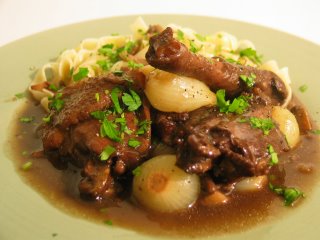
For some obscure reasons, it is now extremely difficult to find Coq au vin at the table of most restaurants with the exception of its various deconstructed versions (e.g. an onion on one side of a rectangular white plate, a delicately stewed piece of chicken in the middle with a wine reduction sauce drizzled around it and a few sautéed wild mushrooms at the other side of the plate).
As a matter of fact, most stews are now only made in some rare home kitchen as they all disappeared from restaurant menus and cookbooks in the 70s, especially here in North America. True: stews are hard to plate in a stylish way and new restaurant trends often focus on design more then on taste. Besides, a whole generation, fed on stew for the entire duration of their childhood have, understandably, came to expect something else from their gastronomic experience. This is not an irreversible tendency however so I encourage all of you to join the fight against the culinary extinction of stews in your own kitchen. This is not just a struggle for the survival of one or a few dishes; it is a struggle for culinary diversity; it is a struggle for kitchen liberation and free expression! Cooking men (and women, to be post-feminist) of all countries, unite!
Well, err… I mean… don’t you feel like winter is a perfect season for cooking stew?
Yesterday, I cooked one of the best chicken stew I know: coq au vin. It is a fairly simple French recipe ideally made with older chicken. I bought two small specimens of what the grocery label identified as ‘mature chicken’. They are, if I am right, hens raised for their eggs but whose old age made them less productive. As such, they were probably of the factory farmed type which I didn’t appreciate much in some recent dishes and that prompted me to research the topic and which was eventually discussed so eloquently by Kate at the Accidental Hedonist. It turns out that these ‘mature chicken’, although not always raised in the best conditions, have much more flavour then regular roasters but their meat can be extremely tough and needs long and patient cooking. When you don’t have the money to invest in free-range organic heritage birds, these are certainly a good cost effective solution for stews and broths. If you do have the money, you are still better with an older specimen; ask your chicken provider in advance.
Here’s my recipe:
First, split each of your chicken into 2 drumsticks, 2 thighs, 2 wings, and 2 breasts. Reserve the carcass to make broth. This is not as easy as it sounds since the older birds are much tougher then most commercially available chicken.
Second, brown the carcass in the oven for 45 minutes at 400º F or until they reach that perfect brown colour. Use it to make a broth adding a simple mirepoix (carrot, celery and onion), bay leaves, a few whole pepper corns and, one or a few sprig of thyme. Let simmer for at least 2 hours of even better as long as 8 to 10 hours skimming regularly. Strain and reserve the broth. (alternatively use store bought broth)
 In the meantime:
In the meantime:- Peel some pearl onions. To do this, you can blanch them in boiling water for a few minutes. After this treatment, the skins should slide off the onion easily.
- Clean a good quantity of mushrooms.
- Brown the chicken in a medium sized pot with some chopped bacon and olive oil. Reserve. (note, you can did the chicken in flour before browning it, this will help
 thickening the sauce)
thickening the sauce) - Brown the mushroom in the fat remaining in the pot. Reserve.
At that point you are ready to really start working on the stew. In the pot where you browned the chicken and the mushrooms, add the chicken and the chicken stock and let reduce by at least half to concentrate the flavour. At that point, add as much red wine as you can afford; I personally used one whole bottle for two small birds (a good chicken stock to wine ratio: 1:1). Adjust seasoning and add one bay leaf and a sprig of thyme (by that time, the bay leaves and thyme from the broth have lost some of their punch). Let simmer for as long as it is needed to cook the chicken minus about 30 minutes (you'll have to use your own judgement as each chicken cooks differently; it took almost 3 hours in my case). Add the onions and mushrooms and finish cooking.
This recipe produces a fairly thin but extremely flavourful sauce. You can thicken it out by adding corn starch mixed in cold water or a commercial sauce thickener. It is absolutely not a necessary step but I personaly like the sauce to be thick enough to stick to my food, not more then necessary though. Finally, a light sprinkle of fresh parsley adds a delicate touch of freshness to this otherwise hearty dish.

I like to serve this delicious stew with noodles but I bet mashed potatoes or even rice would do a great job too but you certainly need to get some kind of starch to soak up the delightful sauce.


2 comments:
What do you think about "lardons" a la Julia Child as opposed to just straight bacon? And by Lardons I mean blanched bacon...
Lardons are great but not always easy to find around here. But now that pork belly is so popular, it is easy to make your own.
Lardons is the classic ingredient for coq au vin, not bacon, of course.
Post a Comment